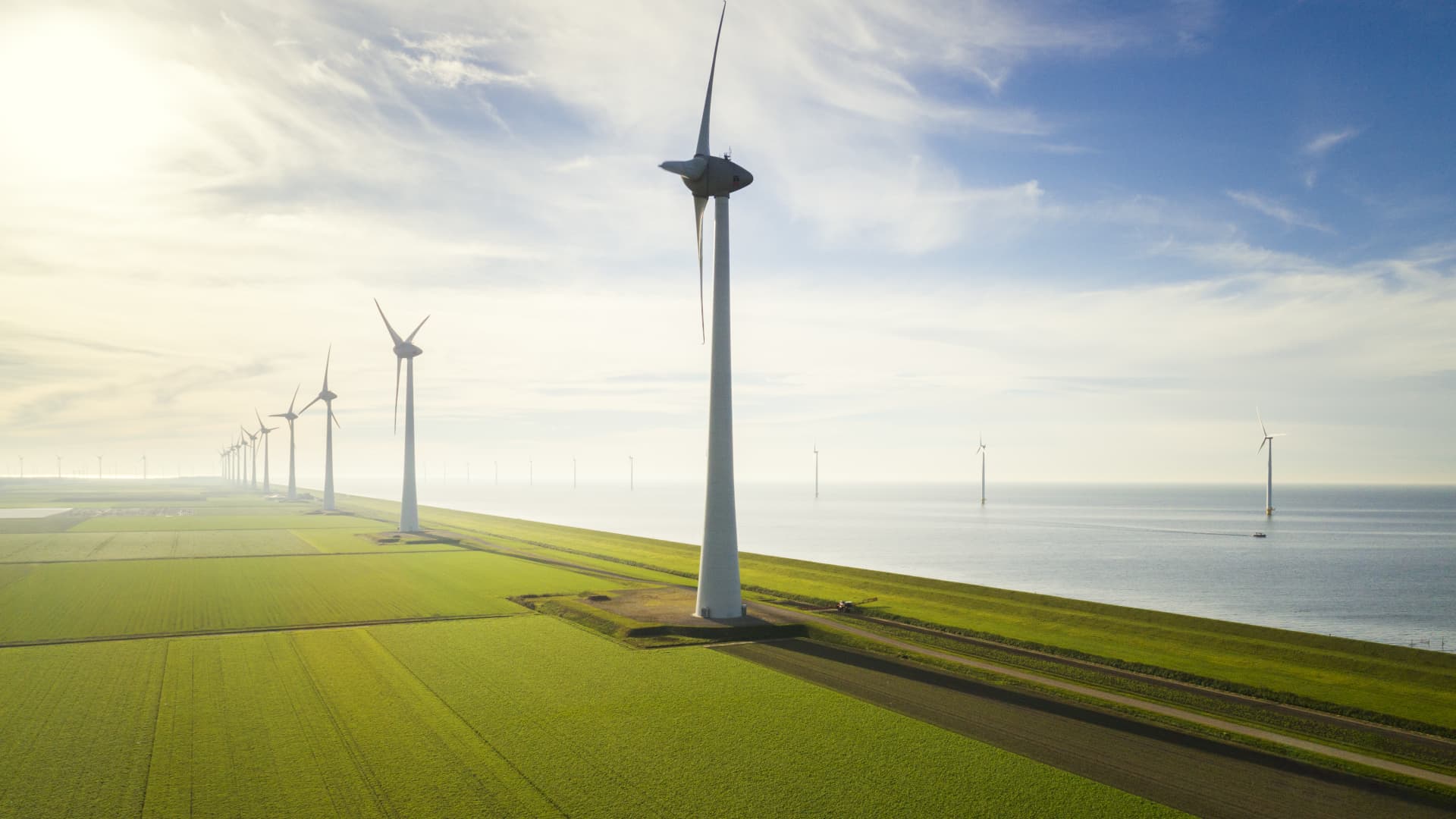
Onshore and offshore wind turbines photographed in Flevoland, the Netherlands.
Mischa Keijser | Image Source | Getty Images
The wind energy sector had its second best year in 2021 but installations will need to dramatically increase going forward to keep track with net-zero goals, according to a new report from the Global Wind Energy Council.
Published Monday, the GWEC’s Global Wind Report 2022 said 93.6 gigawatts of capacity was installed last year, a little lower than the 95.3 GW installed in 2020. Cumulative capacity grew to 837 GW. Capacity refers to the maximum amount of electricity installations can produce, not what they’re necessarily generating.
Breaking things down, the offshore wind segment installed 21.1 GW in 2021, its best ever year. Installations in onshore wind came in at 72.5 GW last year, against 88.4 GW in 2020.
According to the GWEC — whose members include firms like Vestas, Orsted and Shell — the main drivers of the decline in onshore installations were China and the U.S.
For China, where 30.7 GW was installed in 2021 compared to over 50 GW in 2020, the GWEC cited the ending of the country’s feed-in-tariff as the reason behind the drop.
The U.S. installed 12.7 GW of onshore capacity in 2021, a 4.16 GW decline compared to 2020. The GWEC pointed to factors including “disruptions due to COVID-19 and supply chain issues” which “slowed down project construction execution from the 3rd quarter of 2021 onwards.”
Net-zero concerns
Alongside its data, the GWEC’s report also issued a warning and called for a significant ramp up in capacity.
“At current rates of installation,” it said, “GWEC Market Intelligence forecasts that by 2030 we will have less than two-thirds of the wind energy capacity required for a 1.5°C and net zero pathway, effectively condemning us to miss our climate goals.”
The report later added that global wind energy installations “must quadruple from the 94 GW installed in 2021 within this decade to meet our 2050 goals.”
The 1.5 figure refers to the Paris Agreement, which aims to limit global warming “to well below 2, preferably to 1.5 degrees Celsius, compared to pre-industrial levels” and was adopted in Dec. 2015.
According to the United Nations, for global warming to be kept “to no more than 1.5°C … emissions need to be reduced by 45% by 2030 and reach net zero by 2050.”
Among other things, Monday’s report from the GWEC called for procedures related to permitting to be streamlined and “a stronger international regulatory framework to address the increased competition for commodities and critical minerals.”
Huge hurdles
In a statement Monday the GWEC’s CEO, Ben Backwell, said “scaling up growth to the level required to reach Net Zero and achieve energy security will require a new, more proactive approach to policy making around the world.”
“The events of the last year, which has seen economies and consumers exposed to extreme fossil fuel volatility and high prices around the world, are a symptom of a hesitant and disorderly energy transition,” Backwell went on to state.
Russia’s invasion of Ukraine, he said, had “exposed the implications of dependency on fossil fuel imports for energy security.”
“The last 12 months should serve as a huge wake-up call that we need to move decisively forward and switch to 21st century energy systems based on renewables.”
It’s no surprise that organizations such as the GWEC are calling for a ramp up in renewables, but achieving any sort of meaningful change in the planet’s energy mix represents a huge task.
Fossil fuels are ingrained in the global energy mix and companies continue to discover and develop oil and gas fields at locations around the world.
Indeed, in March the International Energy Agency reported that 2021 saw energy-related carbon dioxide emissions rise to their highest level in history. The IEA found energy-related global CO2 emissions increased by 6% in 2021 to reach a record high of 36.3 billion metric tons.
The same month also saw U.N. Secretary General Antonio Guterres warn that the planet had emerged from last year’s COP26 summit in Glasgow with “a certain naïve optimism” and was “sleepwalking to climate catastrophe.”




